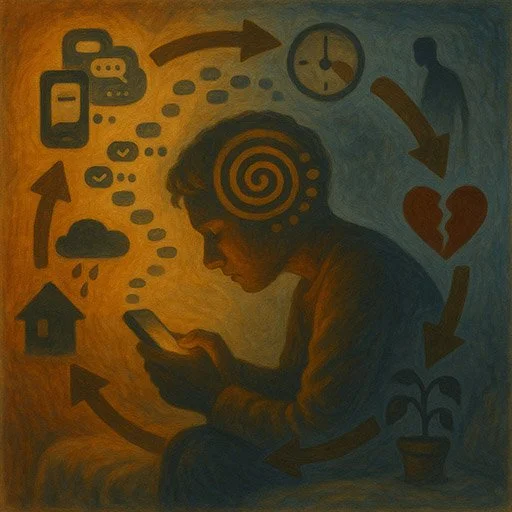Relationship Anxiety and Anxious Attachment: Origins, Symptoms, and Healing with CBT & Meditation
Author: Dr. Timothy Rubin, PhD in Psychology
Published: October 10, 2025
Last Updated: October 10, 2025

That sinking feeling when your partner hasn't texted back—relationship anxiety often stems from anxious attachment patterns formed in childhood.
Contents
- What Is Anxious Attachment?
- How Anxious Attachment Forms in Childhood
- Common Relationship Anxiety Symptoms
- CBT Strategies to Stop Overthinking
- Meditation for Anxious Attachment Healing
- Your Path to Secure Attachment
- FAQ: Anxious Attachment & Relationship Anxiety
Your partner hasn't texted back in three hours. Your stomach drops. You reread your last message ten times, searching for what you said wrong.
Sound familiar? This overwhelming fear isn't "crazy"—it's relationship anxiety, often rooted in an anxious attachment style developed in childhood. If you've ever felt clingy, jealous, or desperate for reassurance in relationships, you're not alone. About 20% of people have anxious attachment patterns.
The good news? Understanding where this anxiety comes from can help you heal it. In this guide, we'll explore how anxious attachment develops, common symptoms, and science-backed strategies using CBT techniques and meditation for anxiety to build more secure, peaceful relationships.
What Is Anxious Attachment?
Anxious attachment (also called "anxious-preoccupied" in adults) is a relationship pattern where you crave intimacy but simultaneously fear abandonment. You desperately want closeness, yet worry constantly that your partner might leave.
This isn't a character flaw—it's an adaptation. Your brain learned early that love can disappear without warning, so it stays on high alert for any sign of rejection. As one therapist explains, that stomach-dropping panic when someone doesn't respond "isn't neediness, it's emotional dependence—a survival mechanism from childhood when love felt unpredictable."
How Anxious Attachment Forms in Childhood

Inconsistent caregiving in childhood teaches children that love is unpredictable, creating anxious attachment patterns.
Anxious attachment typically develops from inconsistent or unpredictable caregiving. When a parent is sometimes warm and attentive but other times cold or unavailable, the child never knows what to expect. This unpredictability teaches the brain: "Love can vanish at any moment, so I must stay vigilant."
Other contributing factors include overprotective parenting (where the child never learns self-soothing), traumatic separations, or parents who use the child to meet their own emotional needs. By adulthood, these patterns become ingrained—but they're not permanent.
From Childhood to Adult Relationships
Fast forward to adulthood, and these early patterns play out in romantic relationships. Someone with anxious attachment tends to doubt their worth ("Am I really lovable?") while idealizing their partner. They manage everyone's emotions to avoid conflict and constantly scan for signs of disconnection.
Important: Having anxious attachment doesn't doom you to unhappy relationships. With awareness and effort, anxious attachment healing is entirely possible. You can learn to feel secure and build healthy, loving relationships regardless of your past.
Common Relationship Anxiety Symptoms
Anxious attachment manifests as intense relationship anxiety—a persistent pattern of fear and insecurity that strains both you and your partner. Here are the most common signs:
Fear of Abandonment
A deep, persistent fear that your partner will leave—even when things are going well. Small things like a grumpy mood can trigger thoughts like "they're going to break up with me." Being alone feels almost intolerable because it activates fears that the relationship is in danger.
Constant Reassurance-Seeking
You compulsively need validation: "Are you sure you love me?" Even after reassurance, the relief is temporary. Individuals with anxious attachment often depend on their partner for self-worth, requiring regular reminders they're loved and "enough."
Overthinking and Catastrophizing
Your mind analyzes every word and action. If your partner takes a while to reply, you reread your messages 20 times. Instead of "they're probably busy," your brain jumps to "they're losing interest" or "they're talking to someone else." This rumination amplifies anxiety in a vicious cycle.
Jealousy and Hypervigilance
You secretly worry you're not good enough, so it's easy to believe your partner could be interested in someone "better." You become hypervigilant—always watching for signs of cheating or rejection, scrolling their social media, needing to know who they're with.
People-Pleasing and Emotional Overdrive
You bend over backwards to keep your partner happy, ignore your own needs, apologize constantly, or say yes to things you don't want. Your mood swings wildly based on the relationship's status: a small reassurance puts you over the moon, while a minor disagreement sends you spiraling.

Overthinking every text message is a hallmark of relationship anxiety—your brain searching for threats that may not exist.
If you recognize these patterns, remember: These behaviors are coping mechanisms you learned to deal with uncertainty—they're not personal failings. The first step to healing is awareness.
CBT Strategies to Stop Overthinking in Relationships
When you're stuck in worry loops about your relationship, Cognitive Behavioral Therapy (CBT) techniques can provide relief. CBT is one of the most evidence-based treatments for anxiety, helping you identify and change unhelpful thought patterns.
For deeper guidance on reframing anxious thoughts, see our complete guide on cognitive restructuring techniques.
Increase Awareness of Thoughts
Start by noticing what you're thinking and when anxiety flares up. Relationship anxiety is fueled by automatic negative thoughts—those worst-case scenarios that pop up ("They're late… they must've gotten in an accident or met someone else").
Keep a mental log of triggering situations. Is it when your partner doesn't text back? When you see them chatting with someone attractive? Mindfulness techniques like pausing to take deep breaths help you step out of the emotional whirlwind. By naming your thought patterns ("I'm having the thought that they might leave me"), you create distance from them.
Challenge Catastrophic Thinking
Once you've identified an anxious thought, gently question it. Ask yourself: "What evidence do I have for this belief?" and "Is there another way to look at this?"
Example: Your partner hasn't responded for hours. Your anxious attachment screams, "They're ignoring me because they're tired of me!" Challenge that: Is there concrete evidence they're losing interest? Or could they be caught up at work, or their phone died? Remind yourself of what you know—like they apologized for being MIA yesterday because of work pressure.
Actively countering fear-driven assumptions with realistic ones stops the overthinking spiral. This technique is called cognitive restructuring—a core part of effective CBT for anxiety treatment.
Accept Uncertainty and Let Go of Control
A hard truth: you cannot control everything about your relationship or your partner's feelings. Anxious attachment tricks you into over-monitoring, which exhausts you and can smother your partner.
When anxious thoughts tell you to send a third follow-up text or check their Instagram, pause. Acknowledge the anxiety ("I really want certainty right now"), then try to sit with the discomfort rather than act on it. Paradoxically, accepting uncertainty can bring more peace. No amount of checking can guarantee outcomes—and that's okay.
Practice Open Communication
Instead of acting out of anxiety, practice expressing your feelings calmly. Use "I" statements: "I sometimes get anxious when we don't talk much during the day—could we check in briefly in the afternoons?" A loving partner will likely be glad to support you, and these conversations are far healthier than unconscious alternatives like picking fights or withdrawing.
Tech tip: There are AI therapy apps that use CBT principles to help with relationship anxiety. These can guide you through reframing thoughts or send reminders to pause and breathe—especially helpful during those 3 AM overthinking moments.
Meditation for Anxious Attachment Healing

Loving-kindness meditation nurtures self-compassion, filling the inner void that anxious attachment creates.
While CBT works on your thoughts, meditation soothes the felt sense of anxiety in your body. For anxious attachment, developing a regular meditation practice can be transformative—it trains your nervous system to shift from "alarm mode" to "calm mode."
Therapists often recommend combining talk therapy with mindfulness techniques for anxiety, since together they help you recognize patterns and build emotional security from within.
Self-Soothing and Emotional Regulation
Meditation teaches self-soothing—exactly what anxious attachers struggle with. By sitting quietly with your breath or doing guided practice, you learn to ride out anxiety waves without immediately reacting. Research shows regular meditation reduces baseline stress and reactivity.
Over time, meditation literally trains your brain toward calmer responses. When your body learns that not every silence is a five-alarm fire, your mind stops catastrophizing too.
Breaking the Thought Spiral with Mindfulness
Mindfulness—staying present—is powerful for relationship anxiety. The present moment is actually safe (nothing bad is happening right this second; the fears are about past or future). Meditation helps you anchor in the now, whether through breathing, mantras, or bodily sensations.
As you practice observing thoughts and letting them pass, you get better at noticing anxious thoughts without buying into them. You might gently tell yourself: "I'm feeling anxiety because this triggers my attachment wound. I don't need to react right now; I can watch this feeling like a wave that rises and falls."
Loving-Kindness for Self-Compassion
Loving-kindness meditation (metta) is especially powerful for anxious attachment. This practice involves sending compassionate intentions to yourself and others by silently repeating phrases like "May I be happy, may I be safe; may you be happy, may you be safe."
For someone who constantly worries "I'm not lovable," loving-kindness is like an antidote. It nurtures self-compassion—treating yourself with the warmth you'd offer a dear friend. Instead of depending solely on your partner for reassurance, you cultivate a sense of love and safety from within.
Research shows loving-kindness meditation significantly reduces anxiety while increasing positive emotions. Learn more about this practice in our complete guide to loving-kindness meditation.
Quick Meditation for Anxious Moments
Beyond daily practice, use brief meditations during anxious triggers. If you notice your heart racing because your partner is unexpectedly busy or distant, try a quick grounding meditation. Even five minutes of guided breathing can signal to your brain that "we are safe."
Some people create personalized meditations for common triggers—recording gentle reminders like "I am loved. I am worthy. It's okay to not have an answer right now." These practices help reframe the narrative in real-time instead of texting in panic or stewing in anxious thoughts.
Your Path to Secure Attachment
Healing anxious attachment isn't a life sentence—it's a rewiring process. With patience and practice, you can shift toward security:
Self-Awareness and Education
Simply learning about attachment styles (as you're doing now) is powerful. When you catch yourself panicking, you can label it: "This is my anxious attachment acting up." Over time, you'll distinguish between real relationship problems and anxiously-skewed perceptions.
Therapeutic Support
Working with a therapist familiar with attachment issues accelerates healing. CBT therapists help you challenge distorted thoughts systematically. Some also benefit from Emotionally Focused Therapy (EFT) or schema therapy for deeper attachment work.
If traditional therapy isn't accessible, bibliotherapy or guided app programs can be alternatives. The key is having a safe space to explore fears and practice new behaviors. For related approaches, see our guide on comparing CBT and DBT for anxiety.
Practice, Patience, and Small Steps
Healing happens in small steps. Celebrate wins: reframing a negative thought, choosing meditation instead of anxious texting, expressing needs calmly. Each is you rewiring your attachment response.
It helps to involve your partner if comfortable. Let them know you have these anxieties and you're working on them. A caring partner can offer support by providing reassurance when needed and gently setting boundaries that help you grow.
Build a Life Beyond Relationships
One paradox: focusing more on yourself often makes you feel more secure with your partner. Invest in identity outside the relationship—hobbies, friendships, passions, career. The more solid your overall self-worth is, the less a relationship hiccup will rock your world.
When you know you can find joy solo, your attachment panic dial naturally lowers. You're not in constant fear of "losing everything," because you have a rich life to fall back on. Counterintuitively, this often improves relationships—you relate from wholeness rather than fear.
For practical daily strategies, explore our guide on daily habits to reduce anxiety.
Be Compassionate with Yourself
Finally, be gentle. Anxious attachment formed in the context of emotional pain—it's an old wound needing care to heal. You might have setbacks when triggers send you spiraling. That's okay. Each time you start again, you're strengthening new patterns.
Over months and years, anxiously attached people can shift toward more secure attachment. Many have done it, and you can too. It's absolutely possible to reach a point where you enjoy relationships with much less fear, where trust comes easier, and where being loved feels safe.
With understanding, CBT techniques, and mindfulness meditation, you're equipping yourself with a powerful toolkit. Bit by bit, you'll teach your inner self it doesn't have to live on high alert anymore. You deserve calm and nourishing love—from others and from yourself.
-Tim, Founder of Wellness AI
About the Author
Dr. Timothy Rubin holds a PhD in Psychology with expertise in cognitive science and AI applications in mental health. His research has been published in peer-reviewed psychology and artificial intelligence journals. Dr. Rubin founded Wellness AI to make evidence-based mental health support more accessible through technology.
FAQ: Anxious Attachment & Relationship Anxiety
How do I know if I have anxious attachment or I'm just needy?
Anxious attachment involves persistent fear of abandonment, constant need for reassurance, and intense worry about relationships even when things are fine. The difference from "normal" worry is the intensity and frequency—if your relationship anxiety is frequent, causes significant distress, and affects your behavior (like not expressing true feelings to avoid rejection), it's likely anxious attachment worth addressing.
Why do I get anxiety when my partner doesn't text back immediately?
Your brain has been conditioned to interpret silence or distance as danger, triggering your fight-or-flight response. This stems from early experiences where love felt unpredictable, so your nervous system learned to treat lack of contact as a threat. Your reaction doesn't match reality—your partner being quiet might have nothing to do with you, but your brain hits the panic button anyway.
Can anxious attachment be changed into secure attachment?
Yes, absolutely. Attachment styles are not permanent—they're default settings that can be updated with new experiences and conscious effort. This process of "earned security" often involves therapy or personal development work to heal old wounds, combined with potentially being in healthy relationships that provide consistent love and respect. The timeline varies, but small improvements can be felt within months.
What are the best therapies for relationship anxiety due to anxious attachment?
CBT is highly effective for targeting anxious thought patterns, while Emotionally Focused Therapy (EFT) helps couples understand attachment needs together. Psychodynamic therapy can explore how childhood influences adult relationships. Beyond formal therapy, mindfulness meditation, journaling, and self-help books can help—the "best" approach is the one you'll stick with consistently.
Is it normal to have some relationship anxiety?
Yes, some insecurity in relationships is common—we all have vulnerable hearts. New relationships especially can stir uncertainty. The difference between "normal" and problematic anxiety lies in frequency, intensity, and impact. If worries are infrequent, short-lived, and don't significantly alter your behavior, that's within normal range. But if you're in constant knots, frequently checking your partner, or unable to concentrate, that's beyond ordinary and worth addressing.